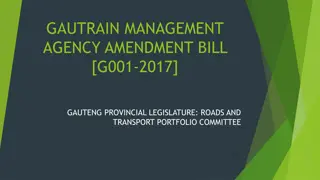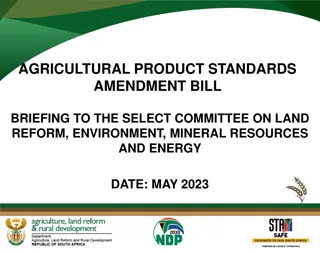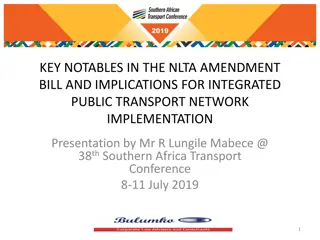National Land Transport Amendment Bill 2018 Overview
The National Land Transport Amendment Bill of 2018 aims to address developments in the land transport system since 2009. It includes provisions for non-motorised and accessible transport, revises public transport contracting arrangements, clarifies government functions, streamlines operating license administrative processes, and empowers the Minister to delay implementation when necessary. The Bill corrects errors and makes consequential amendments to enhance efficiency and compliance with international best practices.
Download Presentation

Please find below an Image/Link to download the presentation.
The content on the website is provided AS IS for your information and personal use only. It may not be sold, licensed, or shared on other websites without obtaining consent from the author. Download presentation by click this link. If you encounter any issues during the download, it is possible that the publisher has removed the file from their server.
E N D
Presentation Transcript
NATIONAL LAND TRANSPORT AMENDMENT BILL, 2018 Presentation to the National Council of Provinces June 2018 1
Contents 1. 2. 3. 4. 5. 6. 7. 8. 9. 10. Provincial transport authorities 11. Impartiality 12. Intermodal Planning Committees Background Main reasons for the Amendment Bill Definitions Functions of the Minister Regulations by Minister Functions of MECs Regulations by MECs Accessible transport and NMT Responsibilities of spheres of government 2
Contents cont. 13. Municipal Regulatory Entities 14. The National Public Transport Regulator 15. Provincial Regulatory Entities 16. Municipal Land Transport Funds, PLTFs and ITPs 17. Rationalisation of public transport services 18. Negotiated contracts and stopgap contracts 19. Subsidised and commercial contracts, and old order contracts 20. Rationalisation of services 21. Operating licences 22. Metered taxis 23. Electronic-hailing services 24. Charter and staff services 3
Contents cont.. 25. Operating licences: general, and cross-border transport 26. Tourist transport 27. General amendments 28. Arrangements between district and local municipalities 29. Transitional provision 30. Amendment of other Acts 31. ConsultationNeville Dingle: 32. Financial Implications 33. Parliamentary Procedure 4
1. Background The National Land Transport Act 5 of 2009 (NLTA) was passed to further the process of transforming and restructuring the national land transport system that was started by the previous Transition Act (NLTTA) The Amendment Bill provides for developments since 2009, such as rolling out of the 2007 Public Transport Strategy The Act has met with much success in achieving its objectives, e.g. consolidating transport functions at the local level There are also some technical issues that have required amendment of the Act 5
2. Main reasons for the Amendment Bill Provision is made for non-motorised transport (NMT) and accessible transport in line with international best practice Some of the contracting arrangements for public transport services are revised The functions of the spheres of government are clarified The administrative arrangements for operating licences (OLs) are streamlined Provision is made for electronic hailing (e-hailing) services The Minister is empowered to delay the implementation of the Act, e.g. while contracting arrangements are put in place Consequential amendments are made and errors are corrected 6
3. Definitions Clause of Bill Section of Act Amendment Purpose of amendment 1(a) 1 New definition of association Needed because Regulatory Entities are required to keep information on associations and routes etc. 1(b) 1 Consequential amendment for new contracting arrangements (see below on clause 7) Def. of contracting authority amended 1(c) 1 Def. of electronichailing services or e-hailing services Provides for electronic hailing (e-hailing) services. See clause 40 below. 1(d) 1 Non-motorised transport (NMT) included and clarifies IRPTNs and IPTNs Def. of integrated public transport network amended 1(e) 1 Provides for the Minister to make regulations on meters for metered taxis Def. of metered taxi service amended 1(f) 1 Makes Act easier to read New def. of Municipal Regulatory Entity 1(g) 1 New def. of non-motorised transport (NMT) Provides for NMT in the Act 1(h) 1 Def. of Rail Commuter Corporation updated to PRASA Updates the Act 1(i), (j), (k) 1 Consequential amendments to definitions Necessitated by other amendments 1(l) 1 New def. of targeted categories of passengers Replaces special categories in line with international usage 7
4. Functions of Minister Clause of Bill 2 Section of Act 5(4)(k) Minister must promote measures to ensure safety of pedestrians and passengers Amendment Purpose of amendment Complements the Act 8
5. Regulations by Minister Clause of Bill Section of Act Amendment Purpose of amendment 3(a) 8(1)(d) Minister s power to make regulations on the process of offering alternative services to operators expanded Experience has shown the need for these regulations 3(b) 8(1)(fA) Power to make regulations to set fees included Omission in Act 3(b) 8(1)(fB) Power to publish codes of conduct for operators and drivers Needed to increase the quality of public transport (PT) services 3(c) 8(1)(h) The Bill will empower the MECs to make these regulations for their provinces Minister s powers to make regulations on colour coding and branding limited to where national uniformity is required 3(d) 8(1)(n) Minister can make regulations on meetings of regulatory entities Will facilitate administration 3(e) 8(1)(y) Minister can publish guidelines on requirements and desired outcomes for vehicles and facilities to accommodate targeted categories of passengers Government policy is to cater for the needs of these passengers 3(f) 8(1)(bbA) Empowers the Minister to make regulations on administrative and procedural matters to enable operators to obtain operating licences (OLs) To enable operators to obtain OLs where they have been unable to do so due to backlogs etc. 3(g) 8(1A) Clarifies that the regulations under section 8(1)(bbA) can include a moratorium or criteria to qualify for an OL Necessary to implement the proposed regulations under section 8(1)bbA) 9
6. Functions of MECs Clause of Bill 4 Section of Act Amendment Purpose of amendment 9(2)(d) Provides that annual reports by the MECs must include the prescribed information Provisions in regulations moved to the Act on advice of the State Law Adviser (SLA) 10
7. Regulations by MECs Clause of Bill 5(a) Section of Act Amendment Purpose of amendment 10(1)(eA) MEC may make regulations on colour coding and branding of vehicles, subject to regulations made by the Minister MEC may make regulations on the composition of PREs, in addition to their powers and duties Provides that before making regulations the MEC must publish a draft for comment Makes for better regulation of public transport (PT) services 5(b) 10(1)(f) Comment by provinces: gap in the Act 5(c) 10(5) Brings the Act into line with section 8(2) which has the same requirement for the Minister 11
8. Accessible transport and NMT Clause of Bill 6 Section of Act 10A Amendment Purpose of amendment New section to promote accessible transport and NMT. Definition of accessible transport included The Minister, MECs and Planning Authorities must take steps to promote accessible transport and NMT 12
9. Responsibilities of spheres of government Clause of Bill Section of Act Amendment Purpose of amendment 7(a) 11(1)(a)(xi) Power included for national government (DoT) to enter into new contracts for PT services At present the Act only provides for the National Government to have powers over old order contracts. Required where there are gaps in PT service delivery 7(b) 11(1)(b)(viiA) Powers are included for provinces to conclude new contracts (negotiated, tendered and commercial contracts) in municipal areas where the municipality does not comply with the prescribed requirements and criteria Provinces need these powers in areas where municipalities lack capacity, to facilitate contracting and unlock deadlocks that may occur, e.g. if the province and municipality cannot agree 7(b) 11(1)(b)(viiB) Powers are included for provinces to conclude contracts for dedicated scholar services Policy decision that scholar transport should be a provincial responsibility 13
9. Responsibilities of spheres of government cont. Clause of Bill Section of Act Amendment Purpose of amendment 7(c) 11(1)(c)(v) Municipalities must do financial planning for land transport in consultation with state-owned rail operators Necessary to achieve co- ordination and integration 7(d), (e), (f), (g) 11(1)(c)(xiv), (xix), (xxii), (xxiv) Consequential amendments and a correction 7(h) 11(1)(c)(xxvi) Provides that powers of municipalities to conclude contracts will only apply to municipalities that meet the prescribed requirements and criteria. Consequential amendment to include stopgap contracts These criteria are listed below. Will replaces assignment of the contracting function to municipalities 7(i) 11(1A) Provides that municipalities may apply to the Minister for exemption from having to go through the process of meeting the criteria contemplated in section 11(1)(c)(xxvi) Enables municipalities such as the larger metros who are already engaged in contracting to continue without the process being stopped. The Minister must respond within 60 days 14
9. Responsibilities of spheres of government, cont. Clause of Bill Section of Act Amendment Purpose of amendment 7(j), (k), (l), (m) 11(2), (3), (4), (5), (6) The Bill will change the principal Act to provide that only the operating licensing (OL) function can be assigned to a municipality, and no longer the contracting function In line with new contracting arrangements mentioned above. Includes consequential amendments 7(n) 11(8), (9), (10) The process of dealing with old order contracts between provinces and municipalities is clarified (i.e. the bus contracts concluded under the Transition Act). Where a province contracts, the services must be in line with the ITPs of the municipalities or designed in collaboration with the municipality The Minister is empowered to make regulations on requirements and criteria to be met by municipalities in order to perform the contracting function To ensure continuity of services and gives effect to municipal functions The Minister is empowered to prescribe the contracting process in regulations and give directives Gives effect to the new contracting arrangements. The criteria and requirements are: An acceptable ITP That the municipality has capacity That the services in the area justify the contract 15
10. Provincial transport authorities Clause of Bill Section of Act Amendment Purpose of amendment Inserted at the request of the Gauteng MEC. In certain cases it makes sense for some specific transport functions to be performed at provincial level 8 12(1), (4), (5), (6) and (7) Provides that provinces may make legislation to establish a provincial entity as a province-wide transport authority in agreement with relevant municipalities 16
11. Impartiality Clause of Bill 9 Section of Act 13(1)(f) and (g) Amendment Purpose of amendment Members of the SAPS, traffic officers and Metro Police are included in the list of persons who may not have a financial or business interest in the PT industry Promotes impartiality 17
12. Intermodal planning committees (IPCs) Clause of Bill 10 Section of Act 15 Amendment Purpose of amendment IPCs must be established by a date to be prescribed by the Minister IPCs only to consist of officials (the Land Transport Advisory Boards include the private sector) Purposes of IPCs expanded The IPC must facilitate a service level agreement with PRASA where there are significant passenger rail services in the area Improvements based on comments and experience 18
13. Municipal Regulatory Entities (MREs) Clause of Bill 11 and 12 Section of Act 17, 18 Amendment Purpose of amendment Consequential amendments and clarifies that MREs will be responsible for services only within their municipal area MREs are required to keep information on operator associations and their members, routes etc. The power to impose a moratorium on specific routes is limited to the planning authority first having to take the steps in terms of section 39 to offer alternate services etc. The keeping of the information is necessary because registration is no longer a national requirement The amendment relating to moratoriums was inserted on instructions from the Portfolio Committee on Transport 19
14. National PT Regulator (NPTR) Clause of Bill Section of Act Amendment Purpose of amendment 13 20 More detail is provided on the appointment and administrative arrangements for the National Public Transport Regulator (NPTR) Gives effect to comments by the National Treasury 14 21 New duties for the NPTR are introduced to deal with passenger complaints, advise the Minister on treatment of passengers etc. The NPTR must keep information on operator associations and members, and routes The NPTR may issue written requests to PREs and MREs where they are not performing their functions Improves functions and duties of the NPTR. If a PRE or MRE fails to respond to such a written request the NPTR may request the Minister to issue a directive under section 5(6). Directive changed to written request on instructions from the Portfolio Committee 20
15. Provincial Regulatory Entities (PREs) Clause of Bill Section of Act Amendment Purpose of amendment 15 23 More detail is provided on the appointment and administrative arrangements for the PRES The functions of PRE members are clarified: when taking decisions they exercise an independent discretion as a quasi-judicial body (i.e. similar to a court) PREs only report to the HoD of the Provincial Department on administrative matters Promotes good administration and clears up a current misunderstanding This aspect has been causing confusion 16 24 Requires PREs to keep information on operator associations, their members, and routes in the case of minibus taxi services. Also makes consequential amendments Necessary because registration is no longer a national requirement: comments from PREs 21
16. Municipal Land Transport funds, provincial land transport frameworks (PLTFs) and integrated transport plans (ITPs) Clause of Bill 17 18 Section of Act 27 35 Amendment Purpose of amendment Corrects an error in the Act The requirement to update PLTFs every 2 years is deleted Paragraph deleted This requirement is regarded as too onerous and expensive Is a duplication of paragraph (b) 19 36(4)(g) 22
17. Rationalisation of PT services Clause of Bill Section of Act Amendment Purpose of amendment 20 39(1)(a) The Act is amended to provide that when a planning authority is rationalising PT services, it may take the steps envisaged in the section to offer operators alternative services, or to impose a moratorium, rather than providing that it must do so. Before doing so it must consult affected operators, and undertake other consultation procedures to be prescribed Provisions to streamline the rationalisation process 20 39(2) Corrects a cross-reference 20 39(3) Adds a new subsection to provide that before taking the steps to rationalise services the planning authority must consult relevant regulatory entities and must first take law enforcement measures to reduce the number of illegal operations on the relevant route. Where appropriate the regulatory entity must take steps under section 78 of the Act to cancel OLs not in use Provisions to streamline the rationalisation process 23
18. Negotiated contracts and stopgap contracts Clause of Bill Section of Act Amendment Purpose of amendment 21 41 Clarifies the meaning of once off in relation to negotiated contracts Procedural provisions currently in the Contracting Regulations are moved into the Act Contracting authorities are only obliged to negotiate with affected operators, i.e. those on the relevant routes The provision that the Minister may publish model contract documents is extended to negotiated contracts Gives effect to comments received This is done on advice from the SLA Deals with problems currently experienced by contracting authorities The Minister should be able to make the documents compulsory for negotiated contracts as well 22 41A Empowers contracting authorities to conclude stopgap contracts for not more than 3 years while they are conducting negotiations for a negotiated contract or establishing a network, to provide continuity of services Will provide continuity of services while the contracting authority negotiates with operators or establishes its integrated network 24
19. Subsidised and commercial contracts, and old order contracts Clause of Bill Section of Act Amendment Purpose of amendment 23 42 Subsidised contracts are made subject to the Municipal Systems Act which provides that a contracting authority does not have to go out on tender when negotiating with a municipal entity or another municipality The provisions empowering the Minister to publish model tender and contract documents are streamlined Will allow municipalities to negotiate with municipal entities rather than always having to go out on tender Provisions streamlined 24 43 Commercial contracts are also made subject to the Municipal Systems Act See above 25 45 This section imposing limitations on the involvement of municipalities in PT services is repealed The provisions came from the Transition Act and are redundant 26 46 Consequential amendments. The requirement to resolve disputes by mediation or arbitration is deleted Due to amendments to section 11 Advice by senior counsel during a dispute in 2012 25
20. Rationalisation of services Clause of Bill Section of Act Amendment Purpose of amendment 27 47 Will extend the deadline for converting permits to OLs for a further 7 years It was not possible to meet the December 2016 deadline and the DoT was required to obtain a declaratory order from the High Court to suspend operation of the provision. The Portfolio Committee decided on 7 years An administrative process will be continued in terms of regulations to ensure completion of the process Provides for administrative measures to streamline the conversion process 28 48(2) Provides that the Minister may make regulations for the conversion of permits for scheduled services to commercial service contracts rather than being required to do so It will take time to develop policy regarding such conversion and such regulations may prove to be unnecessary 29 49 The taxi recapitalisation provisions are amended to clarify them The requirement that the new vehicle may not have a capacity of more than 20% larger than the old vehicle has been removed Due to comments from the PREs and industry 26
21. Operating licences Clause of Bill Section of Act Amendment Purpose of amendment 30 51 Consequential amendment 31 53 Provisions on exemptions clarified: Staff services will be exempt where the employer owns the vehicle and does not charge a fare Farmers carrying workers will only be exempt when conveyance takes place during farming operations. Some consequential amendments are also made Addresses current uncertainties 32 54 Clarifies where applications must be made to MREs Consequential amendment 33 56 OLs must be issued automatically where a stopgap contract is awarded Consequential amendment 34 57 Regulatory entities must also consider contraventions of the codes of conduct when evaluating applications for OLs Some other provisions streamlined Consequential amendment and streamlining 27
21. Operating licences cont. Clause of Bill 35 Section of Act 59 Amendment Purpose of amendment Provides that applications for OLs do not need to be published in certain cases Applications for temporary licences are streamlined Comments from the PREs 36 60 Gives effect to current practice and comments received 37 62 Requirement to submit proof of insurance deleted due to the 2008 amendments to the Road Accident Fund Act Clarifies that an OL can be issued to an accredited tourist transport operator even if he/she is not the owner of the vehicle In terms of the RAF Act operators cannot be sued in the case of accidents except in very limited circumstances Clarifies the use of vehicles in respect of the accreditation system for tourist operators 38 64 28
22. Metered taxis Clause of Bill 39 Section of Act 66 Amendment Purpose of amendment The provision on standards for metered taxis is deleted as it is covered by the Legal Metrology Act, 2013 and other legislation Provides that the Minister may make regulations to regulate standards and requirements for meters and provides minimum requirements for meters The Minister is empowered to regulate meters for metered taxis 29
23. Electronic-hailing services Clause of Bill Section of Act Amendment Purpose of amendment 40 66A This is a new section to regulate e-hailing services and clarify the nature of those services. The section provides that: The Minister may make regulations setting standards and requirements for e-hailing services The OL for the vehicle may also allow it to provide other types of PT services, as allowed by section 50(2) of the Act The Minister may make regulations on requirements for e-hailing applications The regulations must include special markings for e-hailing vehicles The OLs for vehicles used for such services may specify an area of operation, and the section regulates the circumstances in which the vehicle may leave that area The section also creates offences for e-hailing New section inserted on instructions from the Portfolio Committee on Transport E-hailing services were unknown when the principal Act was passed, and experience both in South Africa and overseas has shown that these services need to be regulated and controlled. 30
24. Charter and staff services Clause of Bill 41 Section of Act 67 Amendment Purpose of amendment Limitations are imposed on OLs for charter services: the applicant must show a need for the service and that it will be provided on a regular basis etc. Clarifies that an OL is not required for staff services where no fare is charged and that where staff services are contracted to an operator, he/she requires an OL. Provides that applications for OLs for staff services subject to contracts need not be published To stop abuse of charter OLs: comments from the PREs 42 68 Will eliminate current uncertainty Publication is redundant in such cases 31
25. Operating licences: general and cross-border transport Clause of Bill Section of Act Amendment Purpose of amendment 43 73 Clarifies sizes of vehicles for the purposes of replacement of vehicles Replacement will be automatic if the vehicle is a motor-car, minibus or midibus Will eliminate current confusion These vehicles have a minimal effect on the supply of services on the route(s) even if there is a move say from a minibus to a midibus Such buses can have a substantial effect on the supply on the route(s) Provides that in the case of a bus a new application must be made if it will be more than 40% larger than the replacing vehicle 44 74(1)(a) Allows a vehicle to be replaced temporarily also where the existing vehicle is sold, stolen or destroyed Requests from operators 45 75(3) The subsection contained a presumption that where passengers are loaded within 2 km of an international border, the operator is undertaking cross-border transport. The provision is deleted This provision belongs in the Cross-Border Road Transport Act. The amendment has been agreed to by the Cross-Border Road Transport Agency 46 79 Criteria for withdrawing OLs amended to include contravention of legislation and contravention of a code of conduct Comments from the PREs and consequential amendment 32
26. Tourist transport Clause of Bill 47 Section of Act 81 Amendment Purpose of amendment Provides that applications for accreditation of tourist operators must be published for comment The provisions that accredited tourist operators may use any suitable vehicle are clarified. This includes rented vehicles that are suitable An OL must be issued for the vehicle over the counter . The NPTR may impose conditions when doing so Consequential amendment Omission in Act 48 84 Improvements to and clarification of the accreditation system 49 86 33
27. General amendments Clause of Bill Section of Act Amendment Purpose of amendment 50 90 Adds 2 new offences to section 90 of the Act, i.e. where a person or firm allows a vehicle to be used with an e-hailing application where the operator does not hold an OL or does not disconnect the application when the OL for the vehicle lapses or is cancelled Consequential amendment 51 92 Clarifies and broadens who may appeal to the Transport Appeal Tribunal (TAT) Distinguishes appeals under the Municipal Systems Act Comments received 52 93 The provision that existing transport authorities must be collapsed into the municipality s administration after the date determined by the Minister for the demise of the relevant authority, is amended Will eliminate an anomaly 53 93A To avoid legal challenges, provides that the Minister may delay the implementation of the Act or exempt the NPTR, provinces, municipalities, PREs or MREs from implementing provisions of the Act for set times where practicalities or lack of capacity prevent it (There is a similar provision in the Municipal Finance Management Act, 2003 - MFMA) Suggested inclusion in response to comments received 34
28. Arrangements between district and local municipalities Clause of Bill Section of Act Amendment Purpose of amendment 53 93B Clarifies section 84(1)(g) of the Municipal Structures Act 117 of 1998 as regards the split of PT functions between district and local municipalities Necessary to align the 2 Acts 35
29. Transitional provision Clause of Bill Section of Act Amendment Purpose of amendment 54 N/A Provides that existing contracts concluded by municipalities under the amended section 11 will remain valid until they are cancelled or lapse Transitional provision required by the new provision requiring municipalities to meet prescribed requirements in order to qualify to conclude such contracts 36
30. Amendment of other Acts Clause of Bill Section of Act Amendment Purpose of amendment 55 N/A Provides that the laws mentioned in the Schedule will be amended as follows: Section 23 of the Legal Succession to the SA Transport Services Act, 1989 is amended to provide that PRASA must deliver rail commuter services at the request of a municipality in terms of a service level agreement and subject to budget availability Repeals sections of the Road Transportation Act, 1977 that are redundant and were not repealed when the Act was assigned to the provinces Necessary to implement current policy Necessary to clean up the legislation 37
31.Consultation The following institutions were consulted on the Bill, many of whom provided written comments: The Department of Cooperative Governance and Traditional Affairs(COGTA) The National Taxi Alliance (NTA) The South African Local Government Association (SALGA) The National Consumer Commissioner The Department of Trade and Industry (DTI) The Passenger Rail Agency of South Africa (PRASA) The Cross-Border Road Transport Agency (CBRTA) The South African National Taxi Council (SANTACO) The National Treasury 38
31.Consultation cont. The Department of Tourism The SA Network of Women in Transport (SANWIT) The Southern African Bus Operators Association (SABOA) The Road Traffic Management Corporation (RTMC) The Committee of Transport Officials (COTO) The National Economic Development and Labour Council (NEDLAC) The State Law Advisor (SLA) The eThekwini Metropolitan Municipality The eThekwini Transport Authority The City of Johannesburg Metropolitan Municipality The City of Cape Town Metropolitan Municipality 39
31.Consultations cont. The Kwa-Zulu Natal Department of Transport The Mpumalanga Department of Public Works, Roads and Transport The Limpopo Operating Licensing Board The Limpopo Department of Roads and Transport The Gauteng Department of Roads and Transport The Gauteng Metered Taxi Association The Eastern Cape Department of Transport The Free State Department of Police, Roads and Transport The Western Cape Provincial Regulatory Entity The Western Cape Department of Transport and Public Works The Western Cape Metered Taxi Association 40
31.Consultation cont. The North West Department of Public Works and Roads The Northern Cape Department of Roads and Public Works The South African Tourism Services Association (SATSA) UBER The Special Economic Sectors, Employment & Infrastructure Development Cluster (ESEID) Other municipalities 41
32.Financial Implications The Bill proposes clarifications on roles and powers as well as expansions on definitions and is therefore not expected to have any additional financial implications that were not envisaged by the principal Act. 42
33.Parliamentary Procedure The SLA and the Department are of the opinion that the Bill must be dealt with in accordance with the procedure established by section 76 of the Constitution as it deals with public transport envisaged in Schedule 4 to the Constitution. 43
The End Thank You 44




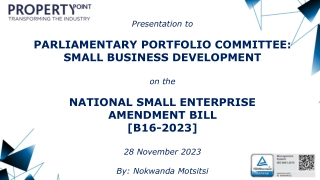
![RE: ELECTORAL MATTERS AMENDMENT BILL [ B42-2023]](/thumb/18837/re-electoral-matters-amendment-bill-b42-2023.jpg)

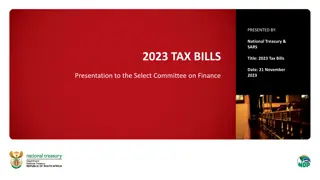
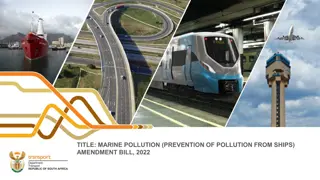
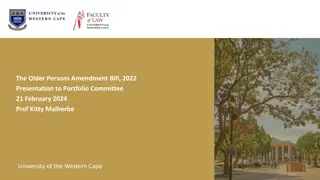
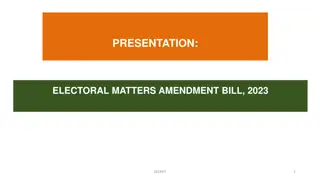
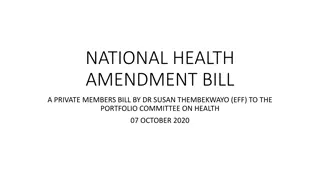

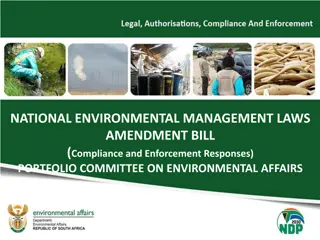
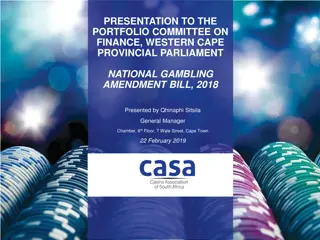

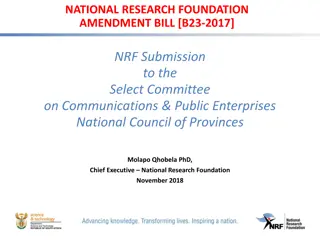

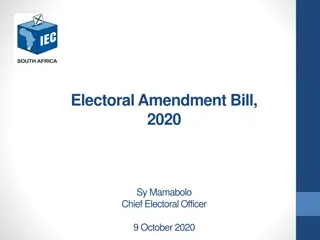

![Briefing on the Criminal Procedure Amendment Bill [B12-2021] to the Portfolio Committee on Justice and Correctional Services](/thumb/157093/briefing-on-the-criminal-procedure-amendment-bill-b12-2021-to-the-portfolio-committee-on-justice-and-correctional-services.jpg)


